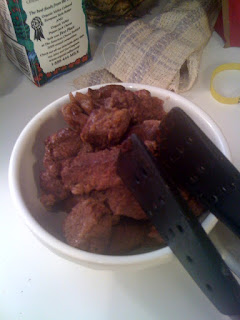Last week I was terrible about bringing my lunch, which resulted in spending way too much money on crappy Midtown food. This week, I am making a conscious effort to be a better brown-bagger and eat food I actually like. Today’s lunch is leftover ‘everyday fried noodles,’ which I made last night from the most recent Saveur issue, paired with my extra white gourd drink that I bought last week.
My trip to Flushing has inspired me to introduce more Asian cooking into my diet – and this happily coincides with the fact that:
a. the two most recent issues of Saveur have focused on Chinese/Taiwanese cuisine, and
b. I own a wok.
This recipe was super simple to execute; the heavy lifting was mainly in the prep work, which really should be done before the wok is put on the flame. It’s a quick process, and you need to be able to dump and go. For the noodles, I could not find lo mein, so I used buckwheat soba noodles instead (high in protein!), which added some color to the dish.
As for the meat, I luckily live by the amazing Marlow & Daughters. I showed up at 5pm on a Sunday and to my dismay saw no ground pork. I asked the butcher what I should use as an alternative, and he replied ‘No worries! I’ll run back and grind you some fresh meat.’ Happy sigh.
Everyday Fried Noodles, or Tian Tian Chao Mian
This article was first published in Saveur in Issue #129


























